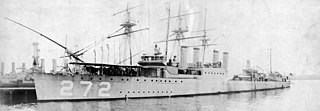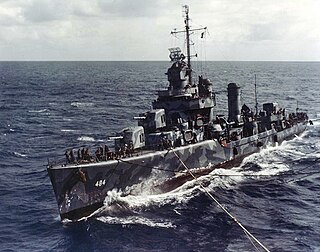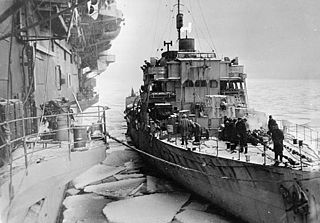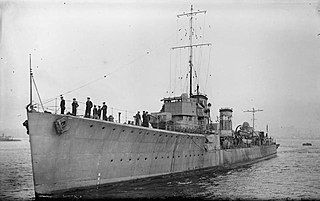
The Sargo-class submarines were among the first United States submarines to be sent into action after the Japanese attack on Pearl Harbor, starting war patrols the day after the attack, having been deployed to the Philippines in late 1941. Similar to the previous Salmon class, they were built between 1937 and 1939. With a top speed of 21 knots, a range of 11,000 nautical miles (20,000 km), and a reliable propulsion plant, along with the Salmons they were an important step in the development of a true fleet submarine. In some references, the Salmons and Sargos are called the "New S Class", 1st and 2nd Groups.

The Clemson class was a series of 156 destroyers which served with the United States Navy from after World War I through World War II.

The Wickes-class destroyers were a class of 111 destroyers built by the United States Navy in 1917–19. Together with the six preceding Caldwell-class and following 156 subsequent Clemson-class destroyers, they were grouped as the "flush-deck" or "four-stack" type. Only a few were completed in time to serve in World War I, including USS Wickes, the lead ship of the class.

USS Murray (DD-97) was a Wickes-class destroyer built for the United States Navy during World War I.

USS McKee (DD-87) was a Wickes-class destroyer built for the United States Navy during World War I.

USS Bell (DD-95) was a Wickes-class destroyer built for the United States Navy during World War I.

USS Anthony (DD-172) was a Wickes-class destroyer built for the United States Navy during World War I.

USS Sproston (DD-173) was a Wickes-class destroyer built for the United States Navy during World War I.

USS O'Bannon (DD-177) was a Wickes-class destroyer built for the United States Navy during World War I.

The Sampson-class destroyers served in the United States Navy during World War I. Commissioned in 1916 and 1917, the class was a modification of the O'Brien and Tucker classes, with the number of 21-inch (533 mm) torpedo tubes increased from four twin-mounts to four triple-mounts. The Sampsons were the final six ships of the 26 "thousand tonner" destroyers. They were the largest and most heavily armed of the "thousand tonners", and the subsequent "flush deck" classes differed mainly in hull design and the engineering plant.

USS Craven (DD-70), later renamed USS Conway (DD-70), a Caldwell-class destroyer, was in commission in the United States Navy from 1918 to 1922 and briefly in 1940, and later in the Royal Navy as HMS Lewes from 1940 to 1945.

USS Tingey (DD-272) was a Clemson-class destroyer in service with the United States Navy from 1919 to 1922. She was scrapped in 1936.

USS McCawley (DD-276) was a Clemson-class destroyer built for the United States Navy during World War I. She was armed with 4 × 4 inch and 2 × 1 pounder guns. She was commissioned on 22 September 1919, served with the Pacific Fleet for 3 years and was laid up on 7 June 1922. McCawley was recommissioned on 27 September 1923, again serving in the Pacific, and decommissioned in 1930 before being sold for scrap.

The Gleaves-class destroyers were a class of 66 destroyers of the United States Navy built 1938–42, designed by Gibbs & Cox. The first ship of the class was USS Gleaves. They were the destroyer type that was in production for the US Navy when the United States entered World War II.

The Farragut-class destroyers were a class of eight 1,365-ton destroyers in the United States Navy and the first US destroyers of post-World War I design. Their construction, along with the Porter class, was authorized by Congress on 29 April 1916, but funding was delayed considerably. Limited to 1,500 tons standard displacement by the provisions of the London Naval Treaty of 1930, the ships were laid down beginning in 1932 and were completed by 1935. After 12 years since the last of the previous class of American destroyers was commissioned, the Farraguts were commissioned in 1934 and 1935.

The Fargo-class cruisers were a modified version of the Cleveland-class cruiser design; the main difference was a more compact pyramidal superstructure with single trunked funnel, intended to improve the arcs of fire of the anti-aircraft (AA) guns. The same type of modification differentiated the Baltimore and Oregon City classes of heavy cruisers, and to a lesser degree the Atlanta and Juneau classes of light cruisers. Changes were made in order to reduce the instability of the Cleveland-class light cruisers, especially their tendency to roll dangerously. The main battery turrets sat about a foot lower and the wing gunhouses were lowered to the main deck. The medium (40 mm) anti-aircraft mounts were also lowered.

HMS Honeysuckle was a Flower-class corvette that served with the Royal Navy during the Second World War. She served as an ocean escort in the Battle of the Atlantic.

HMS Mignonette was a Flower-class corvette that served with the Royal Navy during the Second World War. She served as an escort ship in the Battle of the Atlantic.

HMS Serapis was an S-class destroyer, which served with the Royal Navy during the Greco-Turkish and Russian Civil Wars. Launched on 17 September 1918, the vessel was not completed until after the closing of the First World War. The ship joined the Seventh Destroyer Flotilla in the Reserve Fleet at Rosyth. The ship was then commissioned and sent to Constantinople to support refugees escaping from the conflicts in the Black Sea. The destroyer assisted in the evacuation of the Crimea in 1919 and helped rescue about nine hundred people from Smyrna in 1922. In 1929, Serapis was transferred to Hong Kong to serve in China. However, the signing of the London Naval Treaty in 1930 meant that the Royal Navy looked to retire older vessels. Serapis was sold to be broken up on 25 January 1934.
This page is based on this
Wikipedia article Text is available under the
CC BY-SA 4.0 license; additional terms may apply.
Images, videos and audio are available under their respective licenses.


















